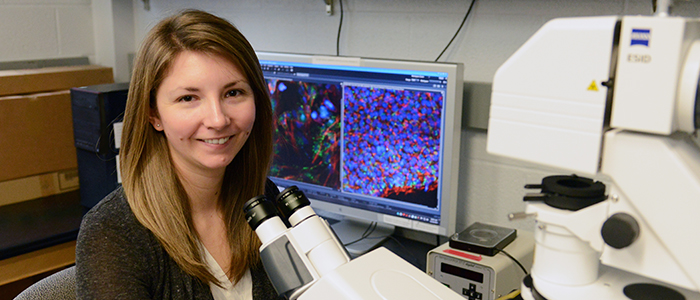Faculty A-Z

Jessica Esseltine
Associate Professor of BioMedical Sciences PhD (University of Western Ontario)BioMedical Sciences
(709) 864-3388
Email:
jesseltine@med.mun.ca
Address:
Faculty of Medicine, Division of BioMedical Sciences | Memorial University of Newfoundland | Health Sciences Center Room 4338 | 300 Prince Philip Dr., St. John's, NL Canada, A1B 3V6
Please check out our lab website here for current research interests, recent publications, and lab personnel.
The focus of my laboratory is to investigate cellular communication in pluripotent and adult stem cells.
Normal communication between cells is essential in the early embryo and throughout development and can become perturbed during disease. Gap junctional intercellular communication (GJIC) facilitates the bidirectional exchange of second messenger molecules, ions, and small metabolites between adjacent cells. Gap junction channels arise from the assembly of connexin proteins (hemichannel) that dock with hemichannels from an adjoining cell to form contiguous gap junction channels. Pannexins, meanwhile, participate in paracrine signaling by forming large-pore membrane channels through which small molecules including ATP can be exchanged with the extracellular milieu.
As in the early embryo, mouse and human stem cells (embryonic, induced pluripotent and somatic) are also functionally coupled by gap junctions. Connexins are dynamically regulated during cellular reprogramming and throughout differentiation. Meanwhile, very few studies have addressed the role of pannexins in stem cells, but they may regulate proliferation of certain types of precursor cells and adult stem cells.
I am especially interested in how intercellular communication influences different states of stem cell pluripotency, self-renewal and differentiation.
My laboratory investigates the following central research questions:
- How do connexins and pannexins contribute to pluripotency and cell fate decisions? Do connexins play divergent roles in differing states of pluripotency or differentiation?
- Do adult stem cells rely on GJIC for quiescence, senescence, differentiation or self-renewal? Is there a role for connexins or pannexins in the stem cell niche?
We use cutting-edge techniques in cell and molecular biology including CRISPR-Cas9 genetic engineering of pluripotent and multipotent stem cells, high-resolution imaging, stem cell and 3D organoid culture.
See Dr. Esseltine's publications here